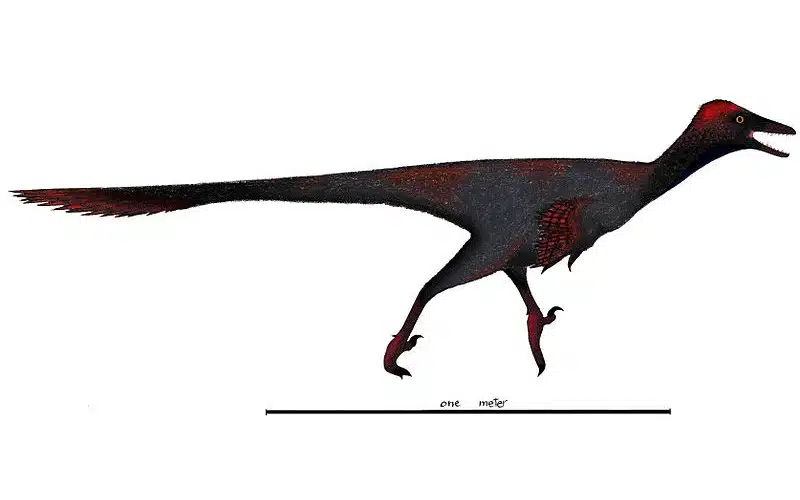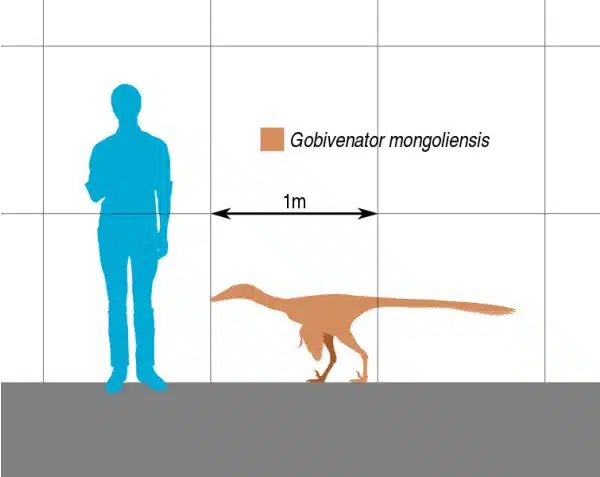Let’s embark on a journey back in time to an era when colossal creatures roamed the Earth. Today, we’re focusing on a fascinating dinosaur, Gobivenator. This intriguing creature, whose remains were unearthed in the vast Gobi Desert, offers a captivating glimpse into the Late Cretaceous Period.
Gobivenator Key Facts
| Keyword | Fact |
|---|---|
| Pronunciation | Go-Bee-Ven-Ah-Tore |
| Meaning of name | Gobi Desert Hunter |
| Group | Theropoda |
| Type Species | Gobivenator mongoliensis |
| Diet | Carnivore |
| When it Lived | 83.6 to 72.1 MYA |
| Period | Late Cretaceous |
| Epoch | Campanian |
| Length | 5.6 feet |
| Height | Approximately 1.3 feet |
| Weight | 20.0 lbs |
| Mobility | Moved on two legs |
| First Discovery | 2014 by Japanese-Mongolian expedition |
| Described by | 2014 by Takanobu Tsuihiji, Rinchen Barsbold, Mahito Watabe, Khishigjav Tsogtbaatar, Tsogtbaatar Chinzorig, Yoshito Fujiyama and Shigeru Suzuki |
| Holotype | MPC-D 100/86 |
| Location of first find | Djadokhta Formation, Gobi Desert |
Gobivenator Origins, Taxonomy and Timeline
This is a dinosaur with a name that resonates with the echoes of the Gobi Desert and the Latin word ‘venator’ meaning hunter, painting a vivid picture of this dinosaur’s origins. Its name not only signifies its geographical roots but also hints at its predatory nature.

Belonging to the theropod group, it is classified within the troodontid. This categorization places it among some of the most intriguing and intelligent dinosaurs. Its only species, Gobivenator mongoliensis, further specifies its unique identity within the vast tapestry of life.
The timeline of this predator is firmly rooted in the Late Cretaceous Period, specifically within the Campanian Epoch. This fascinating creature thrived in a time when the Earth was teeming with diverse and extraordinary life forms near the end of the Age of Dinosaurs.
Discovery & Fossil Evidence
In 2014, it was found by a team led by Takanobu Tsuihiji along with Rinchen Barsbold and Mahito Watabe. The name itself is a nod to its origins, with ‘Gobi’ referencing the desert where it was found, and ‘mongoliensis’ indicating its presence in Mongolia.
The holotype, MPC-D 100/86, is a nearly complete and articulated skeleton including a well-preserved skull. Nowadays, it is housed at the Mongolian Paleontological Center in Ulaanbaatar. This specimen is remarkable for its completeness, missing only the tip of the snout, some cervical vertebrae, lower forelimb bones, certain hindlimb bones, and most gastralia. Its discovery by a Japanese-Mongolian expedition in the central Gobi Desert’s Djadokhta Formation was a groundbreaking event.
What sets this dinosaur apart from other troodontid fossils is not just its completeness but also its state of preservation. Unlike many other troodontid remains, the holotype is fully articulated and preserved in three dimensions. This level of preservation provides an unparalleled window into the anatomy and potentially the lifestyle of this Late Cretaceous hunter. It represents the most complete specimen of a Late Cretaceous troodontid known to date, making it a cornerstone in the study of this fascinating group of dinosaurs.
Gobivenator Size and Description
Small, agile, and intelligent, this dinosaur represents a fascinating part within the evolution of dinosaurs. It was a bipedal carnivore like many of its relatives, capable of darting through the brush in pursuit of its prey. Let’s take a closer look at what this dinosaur may have looked like.
Size and Weight of Type Species

It was relatively diminutive in size, measuring approximately 5.6 feet in length and around 20.0 pounds. These measurements place Gobivenator in the smaller spectrum of theropods, a contrast to the often colossal sizes associated with this group of dinosaurs. Despite its modest size, its anatomical features and adaptations paint a picture of an agile and potentially cunning predator of the Late Cretaceous.
The Dinosaur in Detail
This member of the Troodontidae family was a small, bird-like dinosaur known for its slender and elegant build, typical of the gracile maniraptorans. Its skull bore several unique features such as closely spaced teeth in the lower jaw and a large number of teeth overall, hinting at its carnivorous diet. The presence of sickle-like claws and raptorial hands further suggests a predatory lifestyle.
This dinosaur stood out for its high “encephalization quotient” (EQ), indicating a relatively large brain size compared to its body. This implies advanced behavior and keen senses. Gobivenator’s anatomy provides a window into the evolution of Troodontidae, showing close relations with Dromaeosaurids and basal birds like Archaeopteryx. Its skull, though akinetic (lacking significant movement), displayed early signs of evolutionary traits that would later be crucial in the development of cranial kinesis in birds. In birds, this usually allows them to eat distinct foods such as nuts.
Interesting Points about Gobivenator
- This discovery in the Gobi Desert marks it as a key species in understanding the Late Cretaceous ecosystem of that region.
- Its classification as a Troodontid suggests a high level of intelligence compared to other dinosaurs.
- The excellent preservation of its fossils provides rare and valuable insights into its physical characteristics and lifestyle.
- Its bipedal locomotion indicates a potentially swift and agile hunting strategy.
- Its role as a predator in the Campanian Epoch contributes significantly to our understanding of the food chain and ecological dynamics of the time.
Gobivenator in its Natural Habitat
This Asian dinosaur thrived in an environment that was both challenging and bountiful. The Gobi Desert during the Late Cretaceous presented a landscape marked by arid conditions, interspersed with areas of vegetation. This terrain would have required adaptability and resilience from its inhabitants.

As a carnivore, Gobivenator’s diet was primarily meat-based. Its hunting strategies were aided by bipedal locomotion and would have been crucial in capturing prey. The predator-prey relationships within its ecosystem were likely complex and dynamic, with this carnivore playing a significant role. Its social behavior, whether solitary or in groups, remains a subject of interest and speculation among paleontologists.
The impact of Gobivenator on its environment could have been substantial. As a predator, it would have influenced the population dynamics of its prey and potentially shaped the vegetation and landscape through its activities.
Contemporary Dinosaurs
In the ancient dance of survival where the sun cast long shadows over the Mongolian landscape, our main character navigated a world teeming with both opportunity and peril. Picture this agile, stealthy creature, no larger than a modern turkey, moving with a predator’s grace. Its life was a constant balancing act in a game of predator and prey played against a backdrop of towering dunes and whispering grasses.
Now, imagine Gobivenator’s encounters with Velociraptor, a contemporary that was roughly the same size but perhaps more ferocious. These two might have engaged in a tense ballet, circling each other and assessing whether the other was prey, competitor, or too dangerous to tangle with. Their interactions were likely a complex mix of rivalry and cautious respect as both sought to claim their share of the resources in this ancient world.
But life wasn’t just about competition. Gobivenator also shared its world with Protoceratops, a sheep-sized herbivore. While Protoceratops peacefully munched on low-lying vegetation, our Gobivenator might have eyed it as a potential meal–albeit a challenging one due to its size and defensive capabilities. This dynamic added a layer of tension and strategy to Gobivenator’s existence, constantly calculating the risks and rewards of hunting.
Then there was Oviraptor, a peculiar fellow that was smaller than Gobivenator. Perhaps they competed for eggs or small prey, their paths crossing with mutual wariness. And let’s not forget Pinacosaurus, an armored giant compared to our main dinosaur. Gobivenator would have been wise to steer clear of this behemoth, focusing instead on the smaller, more manageable aspects of its world.
Frequently Asked Questions
It thrived during the Late Cretaceous Period, specifically in the Campanian Epoch.
It was a carnivore, primarily feeding on meat.
It was discovered in 2014 by a Japanese-Mongolian expedition in the Gobi Desert.
It is classified as a Troodontid, indicating a high level of intelligence among dinosaurs.
Its name, Gobivenator, means “Gobi Desert Hunter,” reflecting its origins and predatory nature.
The fossil evidence, particularly the well-preserved holotype, provides valuable insights into its physical characteristics and lifestyle.
Sources
The information in this article is based on various sources, drawing on scientific research, fossil evidence, and expert analysis. The aim is to provide a comprehensive and accurate overview of Gobivenator. However, please be aware that our understanding of dinosaurs and their world is constantly evolving as new discoveries are made.
This article was last fact-checked: Joey Arboleda, 11-04-2023
